
Concept explainers
Label each stereogenic center as
a.  c.
c.  e.
e.  g.
g.
b.  d.
d.  f.
f.  h.
h. 
(a)
Interpretation: The stereogenic center in the given compound is to be labeled as
Concept introduction: A carbon atom that has four nonequivalent atoms or groups attached to it is known as chiral carbon atom. Chiral carbon centers are also called as asymmetric or stereogenic centers.
The naming of chiral center and geometric isomers are based on Cahn-Ingold-Prelog priority rules. If the priority assigned to each group attached to the chirality center in a molecule is in a clockwise direction, then it is the R-stereoisomer, and if this is counter-clockwise, then it is the S-stereoisomer. R and S-stereoisomer are mirror images of each other.
Answer to Problem 5.47P
The stereogenic center has
Explanation of Solution
The
(1) Assign numbering to the groups which are bonded to the chiral carbon based on the molecular weight and electronegativity.
(2) If the sequence of the numbering follows clockwise direction, the chiral atom is assigned
(3) If the sequence of the numbering follows anticlockwise direction, the chiral atom is assigned
(4) If the rotation is clock-wise and the least priority group is above the plane, then the configuration is inverted to the obtained configuration from the above CIP rule which means
In the given compound, the increasing order of priority assigned to the groups attached to chiral center is,
Therefore, the groups in the given compound are numbered as shown below.
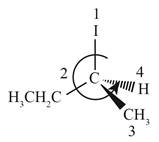
Figure 1
The rotation in the above compound is in anticlockwise direction. Hence, the stereogenic center has
(b)
Interpretation: The stereogenic center in the given compound is to be labeled as
Concept introduction: A carbon atom that has four nonequivalent atoms or groups attached to it is known as chiral carbon atom. Chiral carbon centers are also called as asymmetric or stereogenic centers.
The naming of chiral center and geometric isomers are based on Cahn-Ingold-Prelog priority rules. If the priority assigned to each group attached to the chirality center in a molecule is in a clockwise direction, then it is the R-stereoisomer, and if this is counter-clockwise, then it is the S-stereoisomer. R and S-stereoisomer are mirror images of each other.
Answer to Problem 5.47P
The stereogenic center has
Explanation of Solution
In the given compound, the increasing order of priority assigned to the groups attached to chiral center is,
Therefore, the groups in the given compound are numbered as shown below.
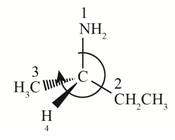
Figure 2
The rotation in the above compound is in clockwise direction and the least priority group is above the plane, then the configuration is inverted. Hence, the stereogenic center has
(c)
Interpretation: The stereogenic center in the given compound is to be labeled as
Concept introduction: A carbon atom that has four nonequivalent atoms or groups attached to it is known as chiral carbon atom. Chiral carbon centers are also called as asymmetric or stereogenic centers.
The naming of chiral center and geometric isomers are based on Cahn-Ingold-Prelog priority rules. If the priority assigned to each group attached to the chirality center in a molecule is in a clockwise direction, then it is the R-stereoisomer, and if this is counter-clockwise, then it is the S-stereoisomer. R and S-stereoisomer are mirror images of each other.
Answer to Problem 5.47P
The stereogenic center has
Explanation of Solution
In the given compound, the increasing order of priority assigned to the groups attached to chiral center is,
Therefore, the groups in the given compound are numbered as shown below.
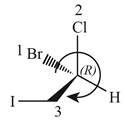
Figure 3
The rotation in the above compound is in clockwise direction. Hence, the stereogenic center has
(d)
Interpretation: The stereogenic center in the given compound is to be labeled as
Concept introduction: A carbon atom that has four nonequivalent atoms or groups attached to it is known as chiral carbon atom. Chiral carbon centers are also called as asymmetric or stereogenic centers.
The naming of chiral center and geometric isomers are based on Cahn-Ingold-Prelog priority rules. If the priority assigned to each group attached to the chirality center in a molecule is in a clockwise direction, then it is the R-stereoisomer, and if this is counter-clockwise, then it is the S-stereoisomer. R and S-stereoisomer are mirror images of each other.
Answer to Problem 5.47P
Both the stereogenic centers has
Explanation of Solution
In the given compound, two chiral centers are present.
Therefore, the groups in the given compound are numbered as shown below.

Figure 4
The rotation of first chiral center in the above compound is in clockwise direction and second chiral center shows anticlockwise rotation. In second chiral center, the least priority group is above the plane, and then the configuration is inverted. Hence, both the stereogenic centers has
(e)
Interpretation: The stereogenic center in the given compound is to be labeled as
Concept introduction: A carbon atom that has four nonequivalent atoms or groups attached to it is known as chiral carbon atom. Chiral carbon centers are also called as asymmetric or stereogenic centers.
The naming of chiral center and geometric isomers are based on Cahn-Ingold-Prelog priority rules. If the priority assigned to each group attached to the chirality center in a molecule is in a clockwise direction, then it is the R-stereoisomer, and if this is counter-clockwise, then it is the S-stereoisomer. R and S-stereoisomer are mirror images of each other.
Answer to Problem 5.47P
The stereogenic center has
Explanation of Solution
The groups in the given compound are numbered as shown below.

Figure 5
The rotation in the above compound is in anticlockwise direction and the least priority group is below the plane. Hence, the stereogenic center has
(f)
Interpretation: The stereogenic center in the given compound is to be labeled as
Concept introduction: A carbon atom that has four nonequivalent atoms or groups attached to it is known as chiral carbon atom. Chiral carbon centers are also called as asymmetric or stereogenic centers.
The naming of chiral center and geometric isomers are based on Cahn-Ingold-Prelog priority rules. If the priority assigned to each group attached to the chirality center in a molecule is in a clockwise direction, then it is the R-stereoisomer, and if this is counter-clockwise, then it is the S-stereoisomer. R and S-stereoisomer are mirror images of each other.
Answer to Problem 5.47P
Both the stereogenic centers has
Explanation of Solution
In the given compound, two chiral centers are present.
Therefore, the groups in the given compound are numbered as shown below.
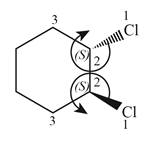
Figure 6
The rotation of first chiral center in the above compound is in clockwise direction and second chiral center shows anticlockwise rotation. In first chiral center, the highest priority group is below the plane, and then the configuration is inverted to
(g)
Interpretation: The stereogenic center in the given compound is to be labeled as
Concept introduction: A carbon atom that has four nonequivalent atoms or groups attached to it is known as chiral carbon atom. Chiral carbon centers are also called as asymmetric or stereogenic centers.
The naming of chiral center and geometric isomers are based on Cahn-Ingold-Prelog priority rules. If the priority assigned to each group attached to the chirality center in a molecule is in a clockwise direction, then it is the R-stereoisomer, and if this is counter-clockwise, then it is the S-stereoisomer. R and S-stereoisomer are mirror images of each other.
Answer to Problem 5.47P
Both the stereogenic centers has
Explanation of Solution
In the given compound, two chiral centers are present.
Therefore, the groups in the given compound are numbered as shown below.
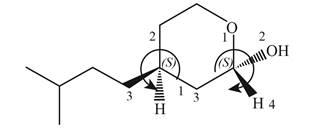
Figure 7
The rotation of first chiral center in the above compound is in clockwise direction and second chiral center shows anticlockwise rotation. In first chiral center, the highest priority group is below the plane, and then the configuration is inverted to
(h)
Interpretation: The stereogenic center in the given compound is to be labeled as
Concept introduction: A carbon atom that has four nonequivalent atoms or groups attached to it is known as chiral carbon atom. Chiral carbon centers are also called as asymmetric or stereogenic centers.
The naming of chiral center and geometric isomers are based on Cahn-Ingold-Prelog priority rules. If the priority assigned to each group attached to the chirality center in a molecule is in a clockwise direction, then it is the R-stereoisomer, and if this is counter-clockwise, then it is the S-stereoisomer. R and S-stereoisomer are mirror images of each other.
Answer to Problem 5.47P
The configurations of three stereogenic centers are
Explanation of Solution
In the given compound, three chiral centers are present.
Therefore, the groups in the given compound are numbered as shown below.
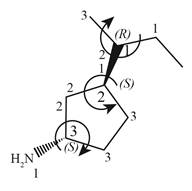
Figure 8
The rotation of first chiral center in the above compound is in clockwise direction. Thus, it has
(a) The stereogenic center has
(b) The stereogenic center has
(c) The stereogenic center has
(d) Both the stereogenic centers has
(e) Both the stereogenic centers has
(f) Both the stereogenic centers has
(g) Both the stereogenic centers has
(h) The configurations of three stereogenic centers are
Want to see more full solutions like this?
Chapter 5 Solutions
Package: Loose Leaf for Organic Chemistry with Biological Topics with Connect Access Card
Additional Science Textbook Solutions
Biology: Life on Earth with Physiology (11th Edition)
Organic Chemistry
Applications and Investigations in Earth Science (9th Edition)
Anatomy & Physiology (6th Edition)
Principles of Anatomy and Physiology
- can someone answer this pleasearrow_forwardcan someone do the reaction mechanism for this reaction and draw the molecules for Q2 and q3arrow_forwardIn this question, the product of the aldol condensation is shown. What would be the reactants for this product? Please provide a detailed explanation, as well as a drawing showing how the reactants will react to produce the product.arrow_forward
- 7. Propene undergoes a hydration reaction with water in the presence of an acid. a. There are two possible products for this reaction, both with the formula C,H,O. Show their structural formulas and names. (A1, B2) SCH4UR Name: (answer for part a. here!) VER 3 2021-2022 b. Which of the two products do you predict will form. Explain your choice using details from your learning. (B3)arrow_forwardWhat are the major products of the following organic reaction? Please include a detailed explanation as well as a drawing as to how the reaction proceeds.arrow_forwardWhat are the major products of the following reaction? Please provide a detailed explanation and a drawing to show how the reaction proceeds.arrow_forward
- What are the major products of the following organic reaction? Please include a detailed explanation as well as a drawing as to how the reaction proceeds.arrow_forwardPredict the organic product that forms in the reaction below: H + гон OH H+ H+ ☑ O Note: You may assume you have an excess of either reactant if the reaction requires more than one of those molecules to form the product. In the drawing area below, draw the skeletal ("line") structure of the missing organic product X. Explanation Check Click and drag to start drawing a structure. S 2025 McGraw Hill LLC. All Rights Reserved. Terms of Use | Privacy Centearrow_forwardIn the analysis of Mg content in a 25 mL sample, a titration volume of 5 mL was obtained using 0.01 M EDTA. Calculate the Mg content in the sample if the Ca content is 20 ppmarrow_forward
- Predict the organic products that form in the reaction below: H. H+ + OH H+ Y Note: You may assume you have an excess of either reactant if the reaction requires more than one of those molecules to form the products. In the drawing area below, draw the skeletal ("line") structures of the missing organic products X and Y. You may draw the structures in any arrangement that you like, so long as they aren't touching. Explanation Check Click and drag to start drawing a structure. G X C © 2025 McGraw Hill LLC. All Rights Reserved. Terms of Use | Privacy Center | Access +arrow_forward111 Carbonyl Chem Choosing reagants for a Wittig reaction What would be the best choices for the missing reagents 1 and 3 in this synthesis? 1. PPh3 3 1 2 2. n-BuLi • Draw the missing reagents in the drawing area below. You can draw them in any arrangement you like. Do not draw the missing reagent 2. If you draw 1 correctly, we'll know what it is. • Note: if one of your reagents needs to contain a halogen, use bromine. Explanation Check Click and drag to start drawing a structure. × ©2025 McGraw Hill LLC. All Rights Reserved. Terms of Usearrow_forwardA student proposes the transformation below in one step of an organic synthesis. There may be one or more reactants missing from the left-hand side, but there are no products missing from the right-hand side. There may also be catalysts, small inorganic reagents, and other important reaction conditions missing from the arrow. • Is the student's transformation possible? If not, check the box under the drawing area. . If the student's transformation is possible, then complete the reaction by adding any missing reactants to the left-hand side, and adding required catalysts, inorganic reagents, or other important reaction conditions above and below the arrow. • You do not need to balance the reaction, but be sure every important organic reactant or product is shown. + T X O O лет-ле HO OH HO OH This transformation can't be done in one step.arrow_forward
 ChemistryChemistryISBN:9781305957404Author:Steven S. Zumdahl, Susan A. Zumdahl, Donald J. DeCostePublisher:Cengage Learning
ChemistryChemistryISBN:9781305957404Author:Steven S. Zumdahl, Susan A. Zumdahl, Donald J. DeCostePublisher:Cengage Learning ChemistryChemistryISBN:9781259911156Author:Raymond Chang Dr., Jason Overby ProfessorPublisher:McGraw-Hill Education
ChemistryChemistryISBN:9781259911156Author:Raymond Chang Dr., Jason Overby ProfessorPublisher:McGraw-Hill Education Principles of Instrumental AnalysisChemistryISBN:9781305577213Author:Douglas A. Skoog, F. James Holler, Stanley R. CrouchPublisher:Cengage Learning
Principles of Instrumental AnalysisChemistryISBN:9781305577213Author:Douglas A. Skoog, F. James Holler, Stanley R. CrouchPublisher:Cengage Learning Organic ChemistryChemistryISBN:9780078021558Author:Janice Gorzynski Smith Dr.Publisher:McGraw-Hill Education
Organic ChemistryChemistryISBN:9780078021558Author:Janice Gorzynski Smith Dr.Publisher:McGraw-Hill Education Chemistry: Principles and ReactionsChemistryISBN:9781305079373Author:William L. Masterton, Cecile N. HurleyPublisher:Cengage Learning
Chemistry: Principles and ReactionsChemistryISBN:9781305079373Author:William L. Masterton, Cecile N. HurleyPublisher:Cengage Learning Elementary Principles of Chemical Processes, Bind...ChemistryISBN:9781118431221Author:Richard M. Felder, Ronald W. Rousseau, Lisa G. BullardPublisher:WILEY
Elementary Principles of Chemical Processes, Bind...ChemistryISBN:9781118431221Author:Richard M. Felder, Ronald W. Rousseau, Lisa G. BullardPublisher:WILEY





